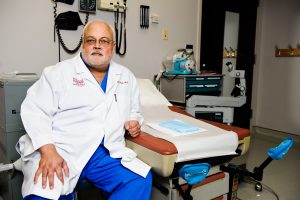
Family medicine physicians play a vital role in the health care of rural communities. From birthing babies and performing routine physicals to addressing the problems that come with age, a family doctor is trained to care for most of the health needs of their patients.
Despite that training, the number of family physicians providing maternity care, or obstetrics, is declining, a trend that is concentrated in rural, underserved areas. As of 2012, only about 10 percent of these doctors were offering obstetrics, says Dr. Daniel M. Avery Jr., professor and chairman of the department of obstetrics and gynecology in The University of Alabama’s College of Community Health Sciences.
Avery and associate professor Dr. John T. McDonald Jr., also in the department of obstetrics and gynecology, addressed the issue of why family physicians have stopped providing maternity care and offered suggestions on how to alleviate the problem in a recent report.
“Half of the counties in the United States have no OB provider,” Avery says. “That leaves some 10 million women in the reproductive age with no local access to OB services. These women might not be able to afford to take off work or have transportation to travel to a town that does offer maternity care, so they don’t get adequate care.”
Not only are there economic factors at play, but not having a local obstetrics provider makes getting prenatal care, as well as delivery, challenging, increasing the risk of premature delivery and complications at pregnancy, he adds.
While fewer medical students are choosing OB/GYN as a career, even fewer are choosing to locate in rural, underserved areas when they finish their residency. These smaller communities, because of their demographics, typically cannot support specialty practices.
“The only practical answer is to increase the number of family docs practicing OB,” Avery says.
There are several reasons family physicians have stopped practicing obstetrics, but some of the more common ones include the fear of being sued, psychological stress, a more demanding schedule and financial concerns.

In addition, some small hospitals have dropped obstetrical services, while other hospitals have made it difficult for family physicians to obtain hospital privileges to deliver babies by implementing policies that, for example, require family physicians to have completed a three-year residency program specializing in obstetrics and gynecology.
Fear of litigation is a concern for many medical practitioners, but especially those who practice obstetrics, Avery says. Most OB/GYNs in Alabama report they have been sued at least once, which results in higher costs for malpractice insurance. On the other hand, family physicians in Alabama are rarely sued and their malpractice insurance is a fraction of what OB/GYNs pay, he adds.
“It just makes good business sense for family physicians to practice obstetrics,” Avery says. “Whereas a small community may not financially be able to support an OB/GYN, it might be able to support two or three family physicians whom also practice obstetrics.”
Physicians practicing obstetrics have hectic schedules, which leads to very little time at home. Family physicians often have to wait all night for a baby to be born and then, when daylight comes, go back to an office full of patients. One way to alleviate that problem is physician support. Collaborative partnerships with other physicians who can provide call coverage, sick leave or vacation time would greatly increase a family physician’s quality of life, Avery says.
“I love being a physician,” he says. “It’s what I always wanted to do. But, it is very stressful. It’s a lot of time, and there’s a lot of worry that goes along with it.
“We really need to encourage medical students who are interested in doing OB,” Avery says. “We need to encourage medical students and residents alike, nurture their interest … because having family medicine physicians do obstetrics is the only answer for addressing the obstetrics need in rural, underserved areas in Alabama.”
